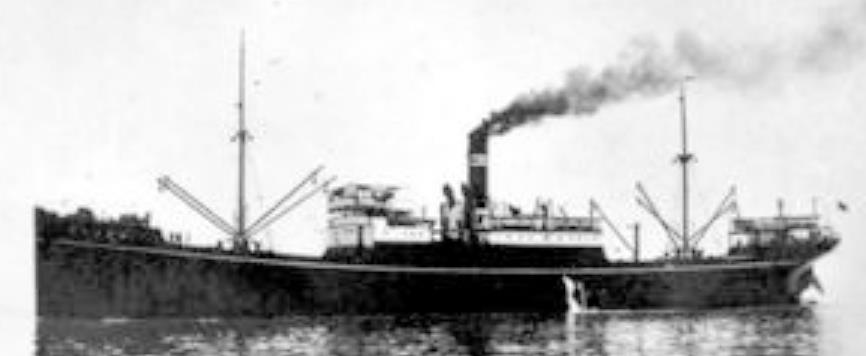RIKUGUN YUSOSEN
 (Sister SURABAYA MARU)
(Sister SURABAYA MARU)
HIBURI MARU:
Tabular Record of Movement
© 2017-2018 Bob Hackett
E 1918:
Osaka. Laid down by Osaka Iron Works Co., Ltd. Sakurajima Plant as a 4, 366-ton cargo ship for Taiyo Steam Corporation, Niihama.
April 1919:
Launched and named HEIJIN MARU.
May 1919:
Completed.
1925:
Sold to Nippon Joint Steamship Co., Ltd. of Niihama.
28 August 1934:
Sold to Manchuria Sea Land Transportation Co., Ltd., Kobe.
17 December 1934:
Renamed SEIKO MARU.
7 October 1935:
Off the Yangtze River. Ran aground. Rescued after repair.
10 August 1936:
After a merger, transferred to Yamashita Kisen Kaisha, K. K., Kobe.
20 February 1940:
Renamed HIBURI MARU.
13 November 1941:
Requisitioned by the Imperial Army (IJA) and allotted Army No. 176.
16 December 1941:
At 1530, destroyer HASU escorting a convoy consisting of HIBURI and TEIYO (ex-German SAARLAND) MARUs, is joined by auxiliary gunboat SHINKO MARU.
17 December 1941:
Arrives at Bei Ji Shan Archipelago, China.
18 February 1942:
At 0800, HIBURI MARU departs Mutsure in the IJA's 56th Infantry Division’s Convoy No. 2 Section also consisting of KAZUURA, KEIFUKU, KOTOHIRA, MYOKO, NAPLES and SANKO MARUs escorted by destroyer FUYO, auxiliary gunboat TOMITSU MARU and auxiliary minelayer KAHOKU MARU. At 1800, the convoy temporarily anchors at Toshin Bay (Tangjin Wan), Chosen (Korea).
22 February 1942:
Arrives at Takao.
19 March 1942: "U" transport operation to Burma (U Sakusen):
The First Burma Transport Convoy departs Singapore carrying the main body of the 56th Infantry Division. The convoy consists of transports: HIBURI, AOBASAN, ATLAS, CALCUTTA, GENOA, GLASGOW, HARUNA, HAVRE, HOFUKU, HOKUMEI, KAZUURA, KIZAN, KOAN, KOTOHIRA, KUSUYAMA, KUWAYAMA, KYUSHU, MEIGEN, MYOKO, MOMOYAMA, NAKO, NAGARA, NAPLES, NICHIRAN, SANKO, SAKITO, SHINAI, SHINANOGAWA, SHINRYU, SHUNSEI, SYDNEY, SUMATRA, TATEISHI, TSUYAMA, TOKIWA, YAE and YAMAZUKI MARUs and six unidentified merchant ships.
The convoy is escorted by the No. 2 Escort Unit comprised of light cruiser KASHII (F), escort SHIMUSHU, minelayer HATSUTAKA, destroyers of DesRon 3 and 5, MineSweepDiv 1's W-1, W-3 and W-4 and SubChasDiv 91's CHOKO MARU and SHONAN MARU Nos. 5 and 7 and the 9th Base Force's gunboat EIKO MARU. Because of size and differing ship speeds the convoy is broken into sections.
23 March 1942: Operation “D” – The Seizure of the Andaman Islands.
At 0200, arrives at Port Blair, Andamans.
25 March 1942: Operation “U” – The Seizure of Rangoon, Burma.
The transports begin landing troops at Rangoon (Yangon, Myanmar).
25 November 1942:
HIBURI MARU departs Saeki for Saipan, Marianas in Military Movement No. 8's convoy “C” also consisting of MINRYO and SORACHI MARUs escorted by torpedo boat HATO and minelayer NASAMI. NASAMI is detached
at an unknown point.
25 July 1943:
At 0740, HIBURI and NICHIREN MARUs depart Batavia, Java (Jakarta, Indonesia) escorted by minesweeper W-16.
28 July 1943:
At 1020, the convoy arrives at Padang, Sumatra.
1 May 1943:
At 1500, HIBURI MARU departs Palau, Carolines in a convoy also consisting of GLASGOW, KANJO, OSUMI, THAMES and YUBAE MARUs escorted by subchasers CH-24 and CH-39.
9 May 1943:
At 1200, arrives at Rabaul, New Britain.
22 May 1943:
At 1500, HIBURI MARU departs Rabaul in a convoy also consisting of KANJO, MEIZAN and YUBAE MARUs escorted by destroyer YUNAGI and subchasers CH-18 and CH-39.'
26 May 1943:
At 1800, YUNAGI is detached from the convoy.
1 June 1943:
Arrives at Palau.
21 September 1943:
HIBURI MARU arrives at Singapore.
6 October 1943:
Departs Singapore for Takao, Formosa.
3 December 1943:
HIBURI MARU departs Naha, Okinawa in convoy OKI-003 also consisting of FUYO and NICHINAN MARUs escorted by minesweeper W-27. At 1800, anchors at Koniya, Amami Oshima where the convoy is joined by BIYO and SUMIDA MARUs and TOYO MARU No. 5.
4 January 1944:
At 0700, departs Koniya. MITSU MARU joins the convoy, but because of engine trouble, straggles and then returns to Koniya.
5 January 1944:
At 1300, MITSU MARU catches up with the convoy. At 2200, arrives Kagoshima, Japan.
18 February 1942:
At 0800, HIBURI MARU departs Mutsure in No. 56 Army Division Convoy No. 2 Section also consisting of MYOKO, NAPLES, KOTOHIRA, KAZUURA, KEIFUKU, HIBURI and SANKO MARUs escorted by destroyer, auxiliary gunboat TOMITSU MARU and auxiliary minelayer KAHOKU MARU. At 1800 the convoy temporarily anchors at Toshin (Tangjin Wan), Chosen.
22 February 1942:
Arrives at Takao.
26 April 1944:
At 2205, HIBURI and FUSHIMI MARUs depart Ominato, Japan for Tenei Island, Kuriles escorted by destroyers NOKAZE and HATSUHARU.
1 June 1944:
Matsuwa Island, Kuriles. About 0700, LtCdr David J. Zabriskie’s (USNA ’36) USS HERRING (SS-233) ) torpedoes and sinks IWAKI MARU unloading in Yawata Bay. 20 soldiers and 30 crewmen are KIA.
HERRING (SS-233) torpedoes and sinks HIBURI MARU also unloading in Yawata Bay. 97 soldiers and 33 crewmen are KIA, but then HERRING herself is sunk with all hands by gunfire from a shore battery of the Matsuwa Detachment of the IJA's Guards Division 52 at 48-00N, 153-00E. [1]
Author's Note:
[1] USS HERRING was the only American submarine sunk by a shore battery in WWII.
Thanks go to Erich Muehlthaler of Germany.
Back
to IJA Transports





